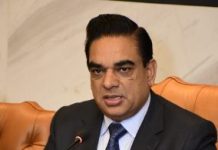ISLAMABAD, DEC 19 (DNA): The government has opposed the K-Electric’s (KE) request for an increase in the multi-year tariff while advising the National Electric Power Regulatory Authority (Nepra) to cut the utility’s rates instead, The News reported on Thursday.
“The inflated costs presented by the KE indicate a lack of consumer-focused planning,” said an official from the Power Division.
Terming the KE’s multi-year tariff proposal as an inflated and unjustified burden on Karachi’s power consumers, the government has suggested the utility supplier’s base tariff be reduced from Rs44.69 per unit to Rs34.87 per unit through a series of targeted cost adjustments.
“Our recommendations aim to introduce fairness and operational efficiency in the KE’s practices while providing much-needed relief to consumers,” added the official.
The move will reduce the burden on the federal government as each year, it pays hundreds of billions of rupees to subsidise the Karachiites and maintain a unified tariff, as the KE’s power generation from its plants is much more expensive than the rest of the country’s generation.
The KE’s tariff petition hinges on projections that the government claims are detached from ground realities. For instance, the utility assumes a compound annual growth rate (CAGR) of 2.9% in peak demand, despite reporting a 7.2% decline in electricity consumption during FY2023.
“Aligning capital expenditures (CAPEX) with realistic growth projections alone could save Rs0.30 per unit,” the Power Division argued.
The government also took aim at the KE’s methodology for calculating its return on equity (RoE). The KE currently uses US Dollar-based indexation, which exposes consumers to currency volatility. By linking RoE to PKR, the government estimates savings of Rs1.20 per unit.
Debt costs in the KE’s tariff were also flagged as overstated. The government says that it is not aligned with current market conditions. By recalculating the debt spread to reflect actual borrowing rates, the Power Division estimates a Rs0.50 per unit reduction in the tariff.
Further reductions were proposed by adjusting the KE’s depreciation rates for its assets. A more accurate depreciation schedule, reflecting the actual wear and tear of assets, would reduce the financial burden passed on to consumers. This measure could lower the tariff by Rs0.20 per unit.
Similarly, the KE’s tariff proposal uses outdated interest rate assumptions, leading to inflated costs. The government has proposed that the utility use current market interest rates instead. By actualising interest rates, the tariff could be reduced by Rs0.95 per unit.
The government has also objected to the KE’s working capital saying this component in its tariff is inflated. By optimising these requirements and basing them on actual financial needs, the government suggests that the tariff could be reduced by Rs1.83 per unit.
One of the most significant interventions recommended by the Power Division involves sourcing up to 50% of the KE’s power from the Central Power Purchasing Agency-Guaranteed (CPPA-G) or the National Grid. Currently, the KE procures only 1,000 megawatts out of its 3,800 megawatts demand from CPPA-G.
“With recent transmission interconnections, the KE can draw more power from the national grid at a lower cost than its own generation,” said an official.
This shift could reduce the tariff by Rs0.28 per unit, easing the financial burden on Karachi consumers.
Karachi-based industrialists and businesses have long advocated for increased reliance on CPPA-G to reduce costs, frequently raising this demand in NEPRA hearings.
The government also proposed transitioning 20% of the KE’s generation contracts to a “take-and-pay” model. Currently, the KE operates on fixed-cost contracts, which require payments regardless of consumption. This transition could save Rs2.51 per unit, the power division suggests.
In addition, the KE’s recovery loss allowances were criticised as overly generous. The government urged NEPRA to benchmark recovery losses against the KE’s best performance — 96.7% achieved in FY2023— rather than its current higher assumptions. This adjustment could save Rs1.47 per unit.
Another key contention is the KE’s retail margin, which the government says is excessive at 1.5% of total revenue. Basing this margin on cost recovery instead of total revenue could reduce the tariff by Rs0.59 per unit.
Consumer advocates and energy analysts have praised the government’s proactive approach.
“The KE has enjoyed far too much autonomy in passing inefficiencies onto consumers. These recommendations are a long-overdue step toward accountability,” said an energy expert.
It is to be noted that the KE petition is currently under review by NEPRA, where the company has sought a massive Rs10.69 per unit hike in the base tariff to Rs44.69 per unit.
Citing a multi-year tariff spanning seven years, the utility aims to establish a multi-year tariff from 2024 to 2030 and has requested the power regulator to validate the cost of power EPP (energy purchase price) components at Rs18.88 per kWh — subjected to monthly and quarterly adjustments based on power costs.
The KE’s request for an increase in tariff includes various cost components such as the cost of power CPP (capacity purchase price) component which amounts to Rs12.54 per kWh which will be revised quarterly.
Meanwhile, the Transmission Charge is sought at Rs3.48 per kWh, while the Distribution Charge is calculated at Rs3.84 per kWh. The Operation and Maintenance (O&M) charges are sought at Rs0.42 per kWh, indexed annually to the Pakistan Consumer Price Index (CPI), and the Retail Margin is estimated at Rs0.59 per kWh, adjusted yearly based on revenue recovery.
Furthermore, the Recovery Loss Allowance, including a cap and floor mechanism for under/over recovery, is calculated at Rs2.88 per kWh. The Working Capital is set at Rs2.07 per kWh, annually adjusted for over/under recovery scenarios.
In pursuit of its perspective, the publication sent the KE a detailed list of questions about the government’s recommendations. These included queries about its inflated CAPEX, USD-based RoE, outdated debt assumptions, and reluctance to increase reliance on CPPA-G.
Despite multiple assurances of a response, the KE declined to provide answers, citing the need to review the government’s document.
Each question was framed based on specific figures from the government’s advisory, yet the KE continued to deflect, raising questions about its accountability and transparency, said a source familiar with the correspondence.
However, sources close to the KE’s investors told the publication that they were only asking for a fair price for their efforts, adding the investors should not be discouraged that they start thinking of getting out of Pakistan’s energy sector.

















